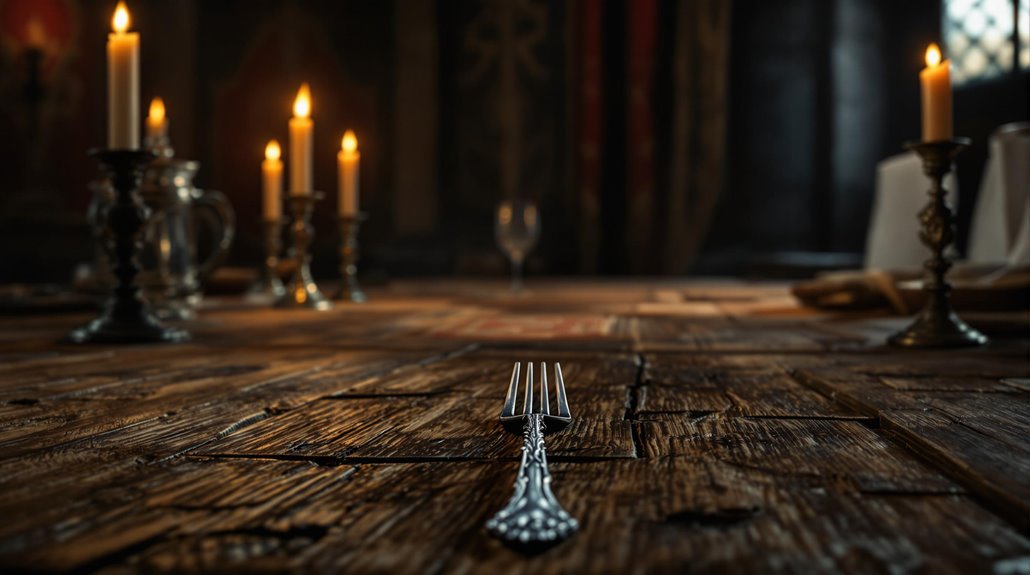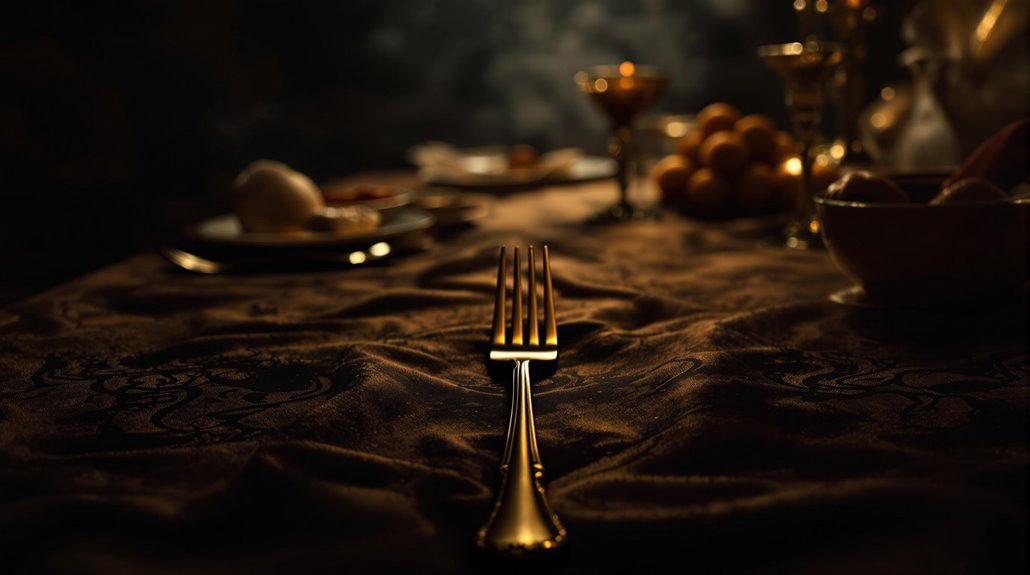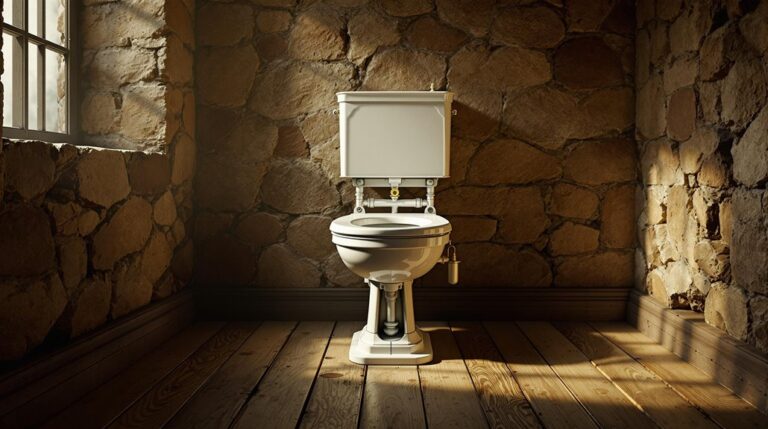Forks Were Seen as Sinful in the Middle Ages
Much like Eve's forbidden fruit, the humble fork sparked an unexpected moral crisis in medieval society. You might think a simple dining utensil couldn't possibly threaten anyone's soul, but for centuries, religious leaders warned against these pronged implements as tools of the devil. From royal courts to monastery dining halls, the mere presence of a fork could brand you as sinfully prideful or, worse, a heretic. There's more to this peculiar chapter of culinary history than meets the eye.
The Devil's Dining Tool: How Forks Became Associated With Evil
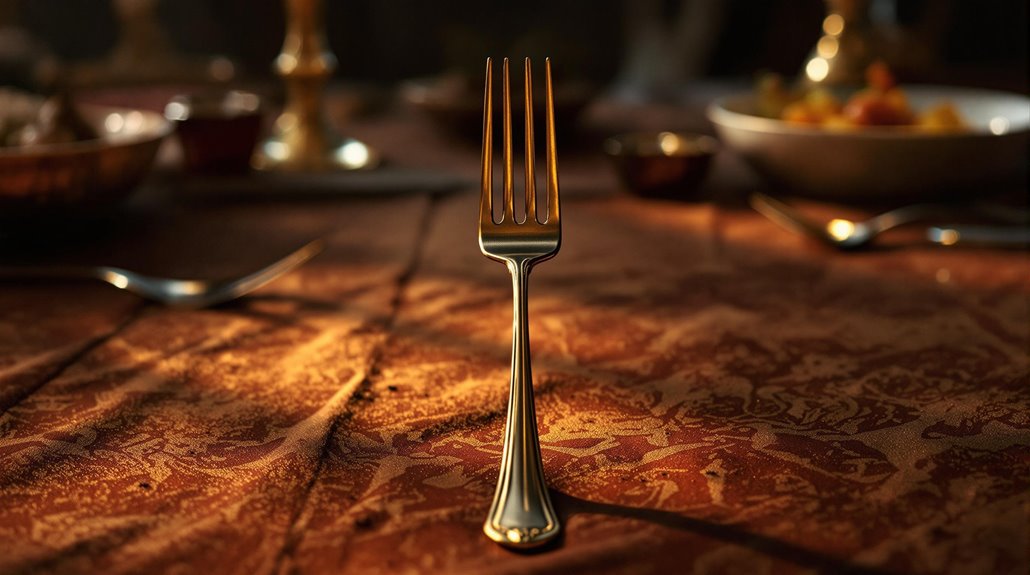
While we take forks for granted today, these simple dining tools were once considered instruments of evil in medieval Europe. The prongs of these utensils bore an unsettling resemblance to Satan's trident, a connection that medieval clergy found impossible to ignore.
This culinary conflict stemmed from both the fork's physical appearance and its association with excess, as demonstrated by the notorious golden forks of Maria Argyropoulina. Even prominent clergy like Peter Damien condemned the use of forks as an insult to God. People were so wary of fork-like implements that they specifically used skewers not forks to mark crosses on bread.
Fork folklore spread throughout Europe, with religious communities viewing these implements as challenges to divine wisdom. You'd find countless artistic depictions of the devil wielding his pitchfork, further cementing the connection between forks and evil.
The resistance was particularly strong among American Puritans, with leaders like John Winthrop explicitly condemning forks as heretical objects. This devilish association would tarnish the fork's reputation for centuries to come.
Divine Fingers Vs Metal Tines: Religious Arguments Against Forks
Because God had already provided humans with ten natural utensils, the introduction of metal forks sparked fierce religious opposition in medieval times.
Religious leaders argued that using artificial utensils insulted God's divine design, as fingers were viewed as perfectly crafted eating tools.
You'll find that finger etiquette was deeply rooted in religious beliefs, with hands considered ritually cleaner than cutlery after washing.
The death of a Byzantine princess was interpreted as divine punishment for her use of forks at the dining table.
The Church viewed forks as symbols of vanity and Eastern decadence, while their pronged design eerily resembled the devil's pitchfork.
This split-tine appearance also raised concerns about schism and disunity among the faithful.
Though forks eventually gained acceptance for specific foods like candied fruits and pasta, some religious communities continued to resist their use, especially during sacred meals.
St. Peter Damian strongly condemned the use of forks as instruments of vanity.
A Princess's Fatal Choice: The Infamous Venetian Fork Incident
In 1004, the arrival of Byzantine Princess Maria Argyropoulina in Venice sparked one of history's most notorious utensil controversies.
When she introduced her golden two-pronged forks during her wedding banquet to Giovanni Orseolo, she violated long-standing Venetian etiquette that favored eating with hands.
You'd be surprised how this seemingly innocent act created an uproar. The local clergy condemned her culinary traditions, labeling her fork "piròn" and comparing it to the Devil's pitchfork.
When Maria died prematurely, likely from plague, religious leaders declared it divine punishment for her "sinful" fork use.
The incident proved so scandalous that forks disappeared from Venice for 70 years until Dogaressa Anna Teodora Dukas reintroduced them.
Having been raised in the Byzantine court with eunuchs, Maria's refined dining habits were far removed from Venetian customs.
Like their Roman predecessors, Venetians used forks only for serving and carving meat at this time.
It wasn't until the 1600s that you'd commonly see forks among Italian merchants and nobility.
Clergy's Campaign: Church Opposition to Table Forks
During medieval times, the Christian Church launched a fierce campaign against the use of table forks, viewing them as blasphemous tools that defied God's natural design.
You'd find clergy opposition ranging from local priests to prominent religious figures like Saint Peter Damian, who claimed fork usage invited divine punishment. Early diners relied on knives and fingers exclusively.
The Church's stance on fork morality was clear: these utensils insulted God's gift of fingers and bore an unsettling resemblance to the devil's pitchfork. When Byzantine princess Maria Argyra brought forks to Venice, they were immediately condemned as symbols of decadence.
Even Martin Luther declared his aversion to forks, while Erasmus dismissed them as feminine frivolity.
Religious authorities went as far as attributing deaths to fork use, considering it divine retribution.
Their influence was so powerful that it greatly slowed fork adoption across Europe, though this resistance eventually faded as the utensil's practicality became undeniable.
Status Symbol or Satan's Silverware: Social Perceptions of Fork Users
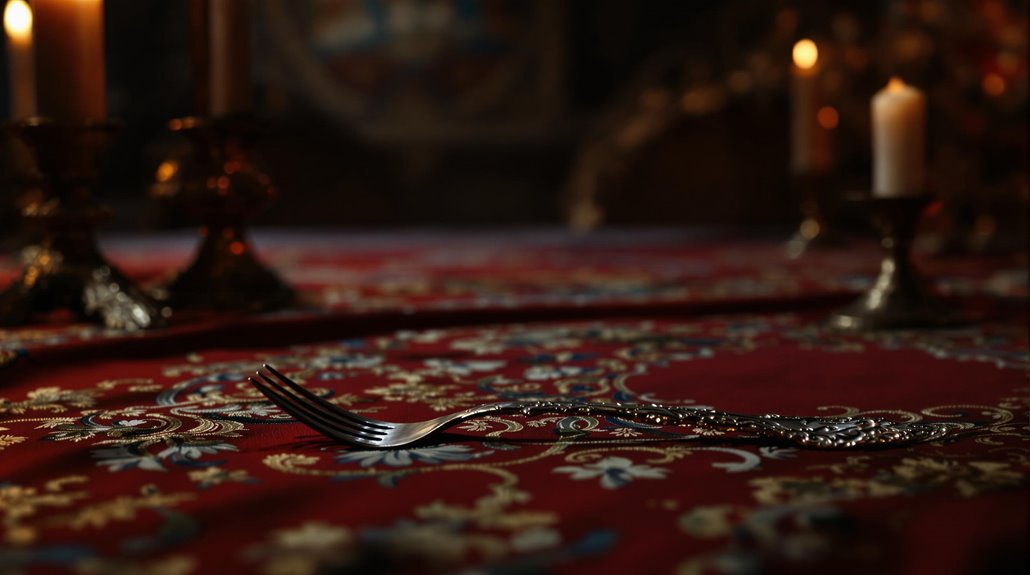
Why did a simple dining tool create such a stark social divide?
If you were wealthy in medieval Europe, you'd flaunt your status through fork fashion – owning ornate utensils made of precious materials.
 dining with Satan. A pivotal moment occurred when a Byzantine princess sparked controversy by using a fork in Venice.
dining with Satan. A pivotal moment occurred when a Byzantine princess sparked controversy by using a fork in Venice.
The social perception of fork users varied dramatically.
In France and England, men mocked forks as overly feminine, with critics like Thomas Coryate being ridiculed as "furciferus."
Meanwhile, noble women, especially in France and Italy, embraced them as sophisticated dining tools.
The Byzantine-influenced utensil was simultaneously viewed as a symbol of Eastern decadence and refined taste.
From Sin to Standard: The Journey to Fork Acceptance
The journey from religious outrage to widespread acceptance wasn't smooth for the humble fork.
Religious figures criticized the use of forks as an insult to God, and the Church banned them as immoral.
You'd find that this cultural evolution began in Italy, where the aristocracy embraced forks by the 14th century, despite fierce opposition from the clergy who viewed them as the devil's tools.
When Catherine de Medici brought forks to France in 1533, she sparked a gradual shift in dining etiquette across Europe.
You'll notice that different regions adapted at varying paces – while Italy and Spain welcomed the innovation, northern Europeans initially dismissed it as an unmanly Italian affectation.
The fork's practical benefits, especially for handling sticky foods and pasta, eventually won over skeptics.
A Byzantine princess first introduced forks to the Venetian court, where her use of the utensil led to her being accused of divine punishment when she fell ill.

